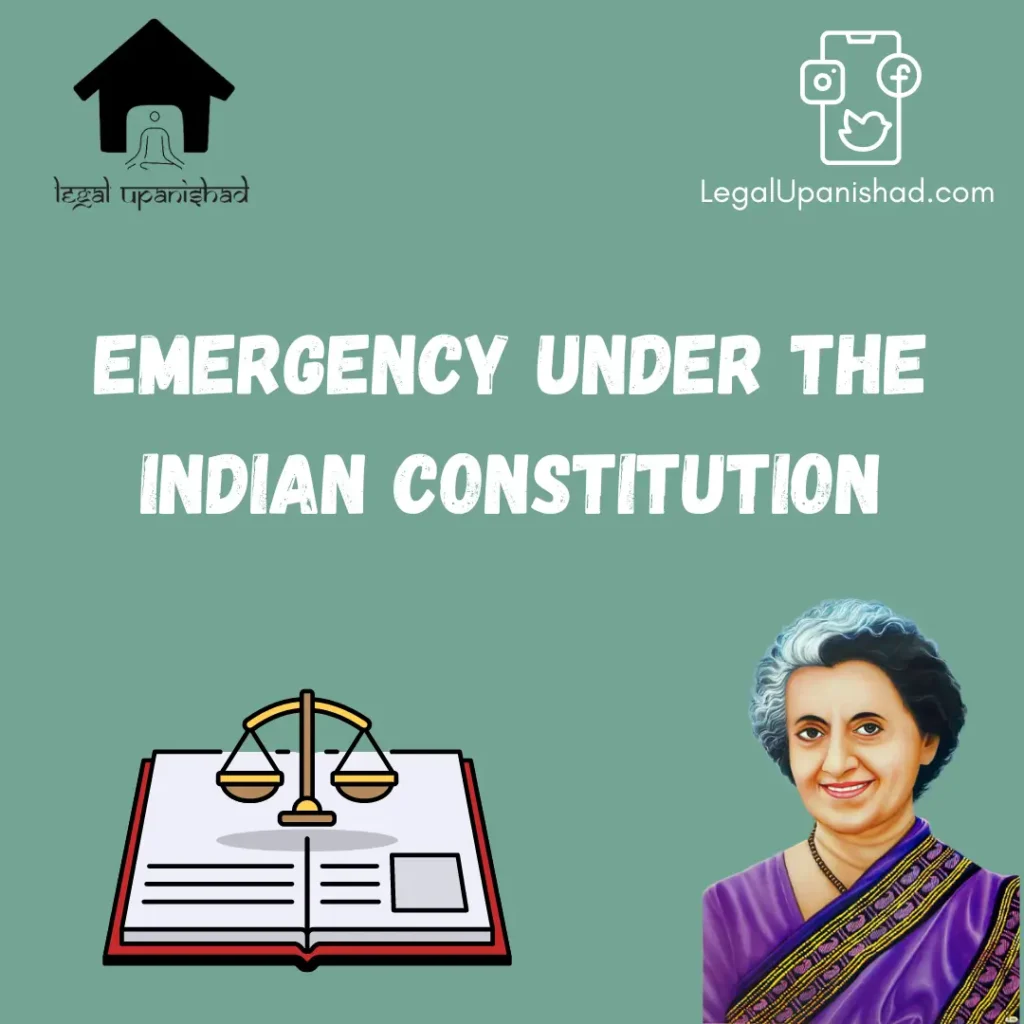This article on ‘Emergency Under The Indian Constitution’ was written by Keerti Tawar, an intern at Legal Upanishad.
Introduction
All relevant provisions related to ‘Emergency’ will be mentioned by the author. Not only that, but we will go back in time to discover the reason for our country’s declaration of emergency if one exists, and the grounds for it. What powers does the president have under the relevant Articles of the Indian Constitution concerning the Declaration of Emergency? Furthermore, we will learn about the validity of our fundamental rights in times of emergency. The author will also highlight the importance of this article’s amendment to highlight essential human rights, even during emergencies.
Emergency Under The Indian Constitution
An Emergency can be declared in any State if such a situation arises wherein the state’s machinery failed, and the Centre has to take control over the subject matter of that State in order to restore Democracy. More precisely, the government in the Centre has to look over or gets the power to make any law in the Concurrent list or, for that matter, if it is in the State list. Only the president has the power to do this. The very reason behind this is for the sake of Security, Democracy and to protect the basic rights of the citizens.
History
The first emergency was declared because of the War with the neighbouring nation ‘China’ which was for six years from October 1962 to January 1968. During this time, China attacked India and that was the very reason behind the proclamation of the first emergency on grounds of external aggression under Article 352. Moreover, the president suspended every fundamental right of the citizens during the period of emergency. During the first emergency, there was an Armed conflict between India and Pakistan that started in April 1965 and after some time in September 1965, it converted into war. Finally, in 1966 both countries reached a peaceful conclusion and signed a Tashkent agreement.
Because of the armed conflict between India and Pakistan, the second emergency was declared in December 1971. If we go back in time, especially during the 1970s, India experienced its third ‘Contentious’ emergency, declared by the President, Fakhruddin Ali Ahmed, on the advice of the Prime Minister of that period, Indira Gandhi. State Emergency was declared in the entire country for 21 months, from 25 June 1975 to 21 March 1977. The proclamation was motivated by both internal disturbances and threats.
The third emergency was contentious for a variety of reasons. Fundamental rights were curtailed, insensitive government programmes such as slum clearance began, members of opposing parties were arrested in large numbers, and press censorship was implemented.
Emergency Under The Indian Constitution
Articles 352 to 360 of the Indian Constitution deal with emergency situations (Part XVIII.) Article 352(1) empowers the President to declare a state of emergency in the event of internal/external disturbances or a financial crisis.
- Article 352 refers to a national emergency,
- Article 356 to a state emergency, and
- Article 360 to a financial emergency. This Article grants the authority to override provisions, which include some fundamental rights.
Furthermore, there is no standard procedure for declaring an emergency; it is entirely up to the President.


Amendments and Approval
As previously stated, Article 352, but following the 44th Amendment Act of 1978, there are grounds for the declaration of emergency, which becomes important during times of national emergency. The grounds were External aggression, war, or Armed rebellion. The 44th Amendment Act added the phrase “armed rebellion,” which replaced the phrase “internal disturbance.” Only on these grounds can an emergency be declared, either for the entire country or for a specific region of the country.
During the 1976 emergency, the 42nd Amendment was introduced, which states that any amendment made by Parliament cannot be challenged in a court of law, implying that there can be no judicial review. Furthermore, the 38th Amendment made the president’s proclamation final and conclusive.
Only after the 44th amendment to Article 358, which talks about Article 19, can Article 19 be automatically suspended in cases of war and external aggression, but not in cases of armed rebellion. Under Article 359, the president may issue a proclamation suspending all citizens’ fundamental rights. However, following the 44th Amendment, Articles 20 and 21 cannot be suspended even in times of emergency. In addition, the court has the authority to issue a writ of habeas corpus. Most importantly, the grounds of emergency can be reviewed by a judge.
Furthermore, a written request from the minister (cabinet) led by the Prime Minister is required. If the president is satisfied with the grounds, the only option is to declare an emergency. Furthermore, the parliament approves such an emergency for six months with a special majority in both houses.
Conclusion
The author would conclude by saying that the purpose of emergency provisions of the Indian constitution is to protect unity, sovereignty, integrity, and security. These provisions are critical in an emergency to protect democracy. Although these provisions were abused during the 1970s, the author believes they are still necessary for our constitution.
List of References
- Rahul Kumar Saini, Emergency provisions in India – a critical analysis, iPleaders Blog, 25 July 2021, available at: https://blog.ipleaders.in/emergency-provisions-india-critical-analysis-2/
- Emergency Provisions, Drishti IAS, 8 August 2020, available at: https://www.drishtiias.com/to-the-points/Paper2/emergency-provisions
- PART XVIII EMERGENCY PROVISIONS, Ministry of External Affairs, available at: https://www.mea.gov.in/Images/pdf1/Part18.pdf
